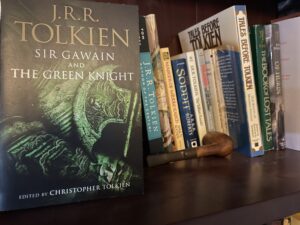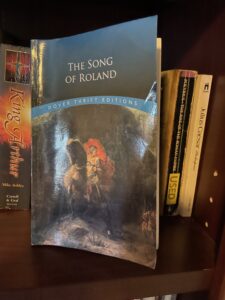
Stories cannot help but build on prior stories. Conventions story tellers are not even aware they are employing all derive from some earlier source. Even the wild and wooly field of speculative fiction, despite its reasonable claim to novelty, owes debts that can be traced back to Homer, if not earlier.
J.R.R. Tolkien, in addition to his own creative endeavors, also translated the works of creators of tales in defunct languages. I picked up a copy of the volume edited by Christopher Tolkien, Sir Gawain and the Green Knight. The book, in addition to that famous story, also contains Pearl and Sir Orfeo. I was familiar with the basic events of Green Knight from prior readings of the corpus of Arthurian legends. (And yes, if you’re asking, I did see the recent film. I will accept traditional advice and not say anything about it.) Reading the poem and the transcript of the lecture Tolkien gave concerning it and his translation provided a deeper and more nuanced experience than a simple recounting of the particulars. The religious and cultural aspects were interesting. But the tale does lack the action and adventure focus of many of the other legends. Not every Arthurian yarn needs to concern itself with who knocked whom from a horse with a long stick, but I genuinely like that aspect, within reason. Gawain’s fixation on rectitude, on right action and behavior stands out in comparison to other depictions of the character. Here he is not the hothead encountered in other tellings of the legends.
Pearl is religious allegory, a dream visitation from the narrator’s deceased young daughter and a tour of Heaven. I am not the one to offer much comment on this one. After the alliterative verse of Green Knight, it was rather pleasant to encounter rhymes.
Sir Orfeo is something of a variation on the Orpheus myth, though with a happier ending. Instead of a trip through the underworld, there is a visit to Faerie. I rather enjoyed it. It seemed to provide a glimpse at one of Tolkien’s inspirations, the conventions that influenced his creative output, consciously or unconsciously.

The Song of Roland predates the stories Tolkien translated. As King Arthur and the Matter of Britain are to England, so Charlemagne and the deeds of the 12 Peers are to France. Entire cycles of stories were created concerning Roland, Olivier, Ogier the Dane, etc., much as they were about Lancelot, Galahad, Percival, etc. As with the Battle of Badon Hill providing some vague factual support for the King Arthur stories, there was an actual battle at Roncevaux that involved some of Charlemagne’s forces being entirely wiped out. But it was by local Basques, not Muslims. Still, there was a fight. And the fight is the focus.
And what a fight. We’re in superhero/mythical territory here. Much as with the early chapters of Malory’s Le Morte d’Arthur, the battles defy credibility. They aren’t, presumably, intended to be realistic. There are some fine depictions of one on one combat, detailing lance’s spitting opponents, or sword strokes cutting both man and horse in half. Semi-plausible up to a point. But then will follow a description of that victorious knight going on to slay hundreds or thousands. Much like in Le Morte d’Arthur. It’s Achille’s-level slaughter before the walls of Troy. More so, even. Roland’s rear guard of 20,000 ends up defeating about a half a million. Roland and Archbishop Turpin, the last two alive, send the remaining few thousand fleeing before succumbing to their wounds. Charlemagne then arrives to take on an even larger army generalled by an even greater villain (as befits the foe of an Emperor.) This army, take note, not only includes men but giants and semi-human monsters. If Zack Snyder ever directed a film adaptation I’m pretty sure these would get vastly more screen time than they got verses. (Note that earlier, in almost an aside, we learn that Turpin kills a sorcerer during the battle. Sadly that potentially interesting incident gets nothing more than a single line.) It’s all pretty wild. Yet so is your average Fast & Furious movie. The tale wasn’t intended to be plausible, merely entertaining.
So it was and thus shall it ever be, or so one can hope. We want our larger than life heroes. We want Beowulf, and Superman, and Breckinridge Elkins, and whomever The Rock is playing this week. That’s what iteration after iteration of Western literature, generation after generation of stories has conditioned us to desire. And that’s fine with me. Programed or not, I like this stuff.
If you like this stuff, you might try some of mine. Give the Semi-Autos and Sorcery series a try. Karl Thorson is rather larger than life himself.
